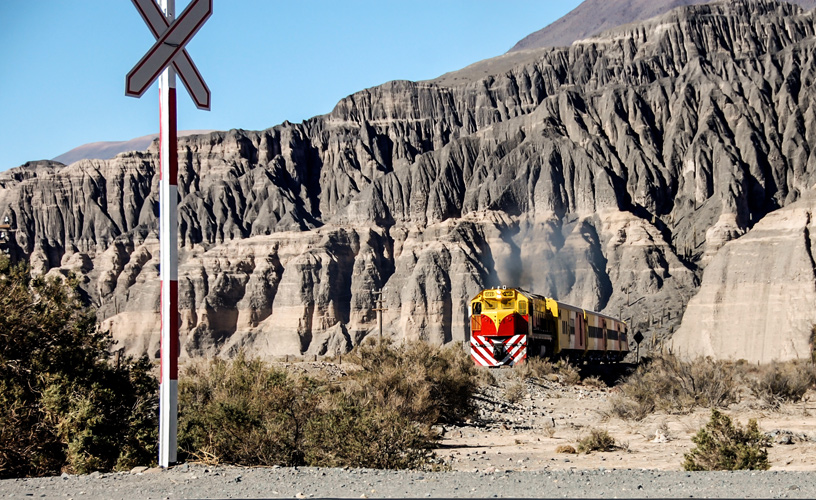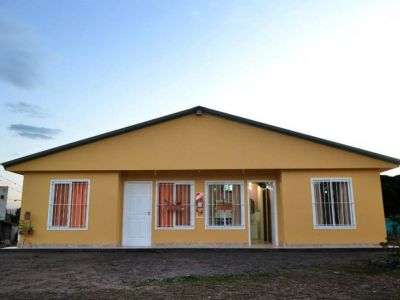Climbing up the mountain by train starting at the City of Salta (1,187 meters) to a height of 4,200 meters above sea level in La Polvorilla and getting to know this tour thoroughly was a strongly desired challenge for us. Salta provides this service once again. We had the chance to travel by train using one of the highest branch lines in the world.
The Dream Came True
As we reached the platform of Salta station on the Belgrano Railway teeming with enthusiasm, there were already some people waiting for the departure of the Train to the Clouds. Our fantasy was to travel back in time and remember the old days, when we used to cover huge distances using this means of transportation almost thrown into oblivion. Moreover, we wished to explore why it had been given the name “to the Clouds”.
A New Chapter of Train to the Clouds
Parked at the platform, the diesel locomotive and its seven cars showed a colorful set. They would carry almost 500 passengers, dining-cars and medical aid, the latter specially conditioned to solve the problems generated by the height. Nothing was trusted to chance.
A guide showed us the way from the entrance steps. The car has comfortable seats, broad windows and the temperature is specially conditioned. There are restrooms on each end and a system of cutting-edge speakers and screens. The complete journey would cover a roundtrip distance of 434 kilometers in 15 hours. A complete adventure without any need to lift one finger.
The Locomotive’s Bell and Whistle
Campo Quijano brandished its impeccable station and the first steam locomotive that traveled along these rails. The first miners settled down here and so do the remains of Mr. Maury, the engineer who fostered this C14 branch line, which joins Salta with Chile.
We went through Del Toro (Bull’s) Ravine and viaduct and the vegetation slowly bade farewell to us. We began to travel amidst very colorful mountains. At El Alisal, we had our first great surprise: two zigzagging rail stretches defy the slope and let the train reach the upper level with just three very simple maneuvers. Euphoria and applause. Inside, no one was sitting.
Games in the Mountain
Provincial Route 51 winds around the mountains crossing the train formation once in a while. This is a moment of joy. We wave and smile at one another from the rails to the road and vice versa.
The next viaduct was El Panteón. Then we saw several abandoned stations and some hamlets with huts made of brick and adobe which give testimony of the presence of populations when this was just a freight train. Inside the car, it was time for the lunch trays. At the same time, passengers might order a hot meal at the dining car, though this was not included in the ticket.
The bilingual tourist guides were constantly giving us information through videos and descriptions of the lifestyle and the customs of the locals, the history of the train, the geographical features and some anecdotes regarding the tasks at the copper mine.
Huge cardons appeared here and there. There were so many and they were so elegant that they looked like an army that saluted us as we passed. At Puerta Tastil, we left all signs of vegetation behind and the sharp summits of the mountains looked like arrow heads. The colors also changed. Green, pink and brown mingled in the various layers of the mountains. Emerald green gives evidence of copper, a typical mineral in the region. As we passed through Muñano Dale and Station, we had a spectacular view of the Acay Snow-capped Mountain, which reaches almost 6,000 meters of height.
More Houses, Less Houses
Some huts made of adobe with their windows and roofs facing the East made us notice we were reaching San Antonio de los Cobres, a high area lying 3,775 meters above sea level where winters are very snowy. We were surprised by the use of solar energy. As we got past the station of the largest settlement in the area, dark-skinned faces and colorful blankets showed their enthusiasm and waved at us joyfully.
Reaching our Destination
We slowly reached the end of the tour. We had a taste of success as we came to that viaduct -so famous for its height- which was built using a special technique and is displayed in so many postcards of La Polvorilla.
Forty-meter-tall iron legs support the steel structure. This is another work done by engineers to save a 200-meter-long depression on the days when this represented an entire technical exploit.
The train stopped and getting off was an adventure. We were on top of the mountain and we could feel the air was different as we breathed in. According to recommendations, we should take short steps and make no effort so that the Puna would not give us any trouble.
The locomotive appeared again in front of the cars and we started our way back to Salta. Afterwards, we stopped at San Antonio de los Cobres, where we had half an hour to spare and visit the handicrafts market.
San Antonio de los Cobres
Now from a closer distance, we greeted those men and women whose faces had been marked by the strong sunshine of the Puna and the wind. They gave us a warm welcome and made us feel as if we were family. The women weave goat, llama and sheep wool and make handicraft textiles which they sell to the passengers. They also display their typical regional dishes, such as locro, empanadas, llama breaded steaks, mote with cheese and grilled lamb.
The Train to the Clouds provides great satisfaction to the local dwellers and the inhabitants of Salta in general, as it represents an emblematic tour and connects the City of Salta with the villages located very close to the Chilean border.
The tour includes thirteen viaducts, two zigzags, two curls and nine tunnels, unique works of their kind.
Towards the end of the circuit, we could feel that we were on top of the mountains. We were told that sometimes the clouds remain still under the train wheels and that is why it has been called the Train to the Clouds.
Mónica Pons
Eduardo Epifanio
Contact of the excursion or tour
Tren a las Nubes
amegino esquina Balcarce , Salta, Salta, Agentina
Phone: +54 387-4228021
Return: 10pm

































